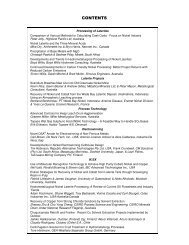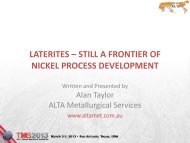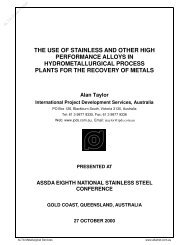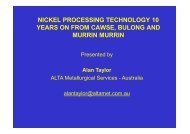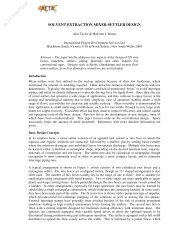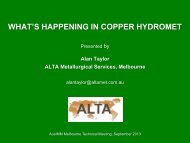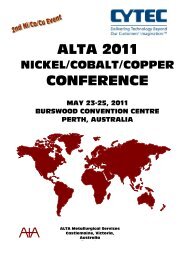the outlook for the pal process - ALTA Metallurgical Services
the outlook for the pal process - ALTA Metallurgical Services
the outlook for the pal process - ALTA Metallurgical Services
You also want an ePaper? Increase the reach of your titles
YUMPU automatically turns print PDFs into web optimized ePapers that Google loves.
<strong>ALTA</strong> Free Paper<br />
THE OUTLOOK FOR THE PAL PROCESS<br />
Alan Taylor<br />
International Project Development <strong>Services</strong>, Australia<br />
PO Box 126, Blackburn South, Victoria 3130, Australia<br />
Tel: 61 3 9877 9335, Fax: 61 3 9877 9336<br />
Web: www.ipds.com.au, Email: ataylor@ipds.com.au<br />
PRESENTED AT<br />
WORLD NICKEL CONGRESS<br />
MELBOURNE, VICTORIA, AUSTRALIA<br />
9 NOVEMBER 2000<br />
<strong>ALTA</strong> <strong>Metallurgical</strong> <strong>Services</strong><br />
www.altamet.com.au
<strong>ALTA</strong> Free Paper<br />
THE OUTLOOK FOR THE PAL PROCESS<br />
Alan Taylor<br />
International Project Development <strong>Services</strong>, Australia<br />
TABLE OF CONTENTS<br />
1. FORTY YEARS ON 1<br />
2. HOW ARE THE WA PAL PLANTS DOING? 1<br />
3. IMPLICATIONS FOR FUTURE PAL PROJECTS 6<br />
4. HOW WILL FUTURE PAL FLOWSHEETS LOOK? 7<br />
5. THE PAL PROCESS IN THE BIG PICTURE 8<br />
6. REFERENCES 9<br />
<strong>ALTA</strong> <strong>Metallurgical</strong> <strong>Services</strong><br />
www.altamet.com.au
<strong>ALTA</strong> Free Paper<br />
1. FORTY YEARS ON<br />
Forty years after <strong>the</strong> commissioning of <strong>the</strong> first PAL plant at Moa Bay Cuba, three new operations<br />
are in <strong>the</strong> ramp-up phase in Western Australia. This paper attempts to assess progress of <strong>the</strong> three<br />
WA operations to date and <strong>the</strong> implications <strong>for</strong> o<strong>the</strong>r PAL projects waiting anxiously in <strong>the</strong> wings.<br />
2. HOW ARE THE WA PAL PLANTS DOING?<br />
The life and times of each of <strong>the</strong> WA PAL plants are briefly reported below, based on in<strong>for</strong>mation<br />
available in <strong>the</strong> public arena.<br />
2.1 CAWSE<br />
Centaur’s Cawse project was <strong>the</strong> late entrant in <strong>the</strong> “Great Laterite Race”, but sprinted past <strong>the</strong> post<br />
to be first to produce nickel, in January 1999. It also appears to be ahead in <strong>the</strong> ramp-up stakes,<br />
meeting or exceeding major design criteria by May 2000, about 20 months after start-up. Ore<br />
throughput was 105% of design, and nickel production was over 90% of nameplate. The nickel<br />
cathode product was reported to average 99.76% Ni in June 2000, close to <strong>the</strong> LME grade of<br />
99.8%, with only zinc being above specification. Consumptions of major reagents are below<br />
design. The operation is now said to be in <strong>the</strong> optimisation phase, with focus on areas such as<br />
steam, power and water to improve efficiencies and reduce costs. Cash operating costs <strong>for</strong> <strong>the</strong><br />
June 2000 quarter were reported to be US$1.88/lb after cobalt credits at US$13.77/lb cobalt. The<br />
corresponding figures <strong>for</strong> July and August 2000 were US$2.09/lb and US$1.42/lb respectively.<br />
Major milestones:<br />
Sept 1998<br />
Dec 1998<br />
Jan 1999<br />
Jan-Mar 1999<br />
Leaching commenced<br />
First cobalt sulphide<br />
First nickel<br />
Nickel close to 99.8% Ni, & cobalt sulphide 35-40% Co<br />
Apr-June 1999 Ave nickel & cobalt leach extractions > 90%<br />
Aug 1999<br />
Cash positive<br />
Leach extractions 95%, overall recoveries 85%<br />
Nov 1999<br />
Jan 2000<br />
80% Ore throughput<br />
85% Autoclave availability<br />
Overall recoveries 90% cobalt & 87% nickel<br />
Feb 2000<br />
May 2000<br />
80% Nickel production<br />
Major design criteria met or exceeded<br />
Ore throughput 105% design<br />
Nickel production > 90% nameplate<br />
Major reagents consumptions below <strong>for</strong>ecast<br />
Problems encountered:<br />
International Project Development <strong>Services</strong> Page 1 November 2000<br />
<strong>ALTA</strong> <strong>Metallurgical</strong> <strong>Services</strong><br />
www.altamet.com.au
<strong>ALTA</strong> Free Paper<br />
The basic <strong>process</strong> at Cawse has worked satisfactorily, as evidenced by <strong>the</strong> early achievement of<br />
high leach extractions, close to specification products and less than <strong>for</strong>ecast consumptions of major<br />
reagents. Although significant problems have been experienced, <strong>the</strong>se have been largely overcome<br />
and no fatal flaw has emerged. The problems encountered have been mainly related to materials,<br />
availability and operational issues. Because of <strong>the</strong> materials involved, time <strong>for</strong> procurement of<br />
replacement parts has sometimes been lengthy. In assessing <strong>the</strong>se issues, in particular those<br />
connected with <strong>the</strong> pressure leaching area, it should be borne in mind that Cawse currently includes<br />
a single autoclave. Down-time should be less disruptive <strong>for</strong> an expanded multi-stream operation.<br />
Key issues include:<br />
• Initial cracks in autoclave titanium lining welds. (Rectified satisfactorily.)<br />
• Equipment failure and localised material corrosion due to upset <strong>process</strong> conditions, faulty lining<br />
application or incorrect material selection in <strong>the</strong> pressure leach area, such as pumps, valves<br />
and piping. (Progressive review and upgrading undertaken.)<br />
• Poor per<strong>for</strong>mance of autoclave isolation valves. (Modified valves procured.)<br />
• Bogging of autoclave agitators with sludge. (Resolved by operating strategies to control sludge<br />
<strong>for</strong>mation, and modifications to allow sludge to pass through autoclave.)<br />
• Scale build-up in desalination unit, which reduced water availability to <strong>the</strong> power station <strong>for</strong><br />
steam generation. (Alleviated by chemical dosing, and improved operating and maintenance<br />
procedures. Long term solution is a standby desalination unit and increased treated water<br />
storage.)<br />
• Unreliability of sulphur pumps. (Additional larger pump installed.)<br />
• Scale build-up in <strong>the</strong> ammonia re-leach area, which limited throughput and metal production.<br />
(Alleviated by installation of duplicate lines and implementation of descaling procedures.)<br />
• Higher than specification zinc level in nickel product. (Enhancements have been developed,<br />
and will be implemented progressively.)<br />
• High manganese content of high grade cobalt ore which led to high lime consumption and high<br />
recirculating loads. (Countered by reducing <strong>the</strong> proportion of high cobalt ore to maintain<br />
manganese levels at less than 3%.)<br />
Autoclave scale growth has not proven to be a significant issue, as indicated by <strong>the</strong> pilot plant<br />
testwork.<br />
2.2 BULONG<br />
Bulong was <strong>the</strong> pioneer of <strong>the</strong> three projects, with <strong>the</strong> development program commencing in 1988,<br />
and was second past <strong>the</strong> post to produce nickel in February 1999. It is also second in ramp-up,<br />
reporting that <strong>the</strong> plant operated close to design capacity during September 2000, some 21 months<br />
after <strong>the</strong> initial introduction of feed to <strong>the</strong> leach autoclave. Ore throughput was 98% of design,<br />
nickel production was 86% of design while cobalt was 77.5%. LME grade nickel, including impurity<br />
specifications, was achieved in June 1999; however <strong>the</strong> nickel grade subsequently dropped below<br />
99.8% due to increased cobalt levels caused by <strong>the</strong> utilisation of one of <strong>the</strong> cobalt solvent extraction<br />
stages to combat <strong>the</strong> gypsum precipitation problem. A grade of 99.67% was reported <strong>for</strong> August<br />
2000. The ramp-up has been leng<strong>the</strong>ned by a number of extended shut-downs to carry out<br />
modifications and repairs. A cash cost of A$10,720 per tonne of nickel plus cobalt was reported <strong>for</strong><br />
September 2000, equivalent to A$185 per tonne of ore.<br />
International Project Development <strong>Services</strong> Page 2 November 2000<br />
<strong>ALTA</strong> <strong>Metallurgical</strong> <strong>Services</strong><br />
www.altamet.com.au
<strong>ALTA</strong> Free Paper<br />
Major milestones:<br />
Dec 1998<br />
Dec 1998-Jan 1999<br />
Feb 1999<br />
Leaching commenced<br />
Seven-week shut-down to replace defective<br />
components <strong>for</strong> leach agitators, plus modifications to<br />
SX piping<br />
First nickel<br />
Mar 1999 Leach extractions 95%<br />
Throughput 80% of design<br />
April 1999<br />
Nickel 99.8% grade<br />
Close to design ore throughput<br />
Leach availability close to 80%<br />
May 1999<br />
June 1999<br />
Aug 1999<br />
May-June 2000<br />
Sept 2000<br />
First cobalt cathode<br />
Nickel met LME spec<br />
Cobalt 98.6% grade<br />
Leach run at design after installation of larger chokes<br />
Six-week shut-down to repair nozzles in heaters &<br />
flash tanks plus o<strong>the</strong>r modifications/maintenance work<br />
Plant operated close to design capacity<br />
Ore throughput 98% of design<br />
Nickel production 86% of design<br />
Cobalt production 77.5% of design<br />
Overall plant utilisation 78.5%<br />
Cash cost A$10,720/t Ni+Co & A$185/t ore<br />
Problems encountered:<br />
As with Cawse, <strong>the</strong> basic <strong>process</strong> has worked satisfactorily, as evidenced by <strong>the</strong> early attainment of<br />
high leach throughput and metal extractions, and close to design product grades. Significant<br />
problems have been encountered which have resulted in several major shut-downs, exacerbated by<br />
<strong>the</strong> lengthy time required to obtain parts made from materials such as various grades of titanium.<br />
The problems have now been largely overcome and no fatal <strong>process</strong> flaw has emerged. As with<br />
Cawse, Bulong has only a single autoclave. This, toge<strong>the</strong>r with <strong>the</strong> absence of an intermediate<br />
nickel precipitation, means that total plant shut-downs have been required to undertake<br />
modifications and maintenance. The effects would be lessened with an expanded multi-stream<br />
operation.<br />
• Initial cracks in autoclave titanium lining welds. (Rectified satisfactorily.)<br />
• Corrosion and cracking of agitator hubs in autoclave. (Replacement of parts with upgraded<br />
materials.)<br />
• Solvent extraction piping undersized limiting solution flows. (Rectified by extensive<br />
modifications.)<br />
• Mechanical and control problems with boiler restricting steam supply to leach. (Resolved in<br />
conjunction with boiler supplier.)<br />
International Project Development <strong>Services</strong> Page 3 November 2000<br />
<strong>ALTA</strong> <strong>Metallurgical</strong> <strong>Services</strong><br />
www.altamet.com.au
<strong>ALTA</strong> Free Paper<br />
• Leach throughput restricted by undersized choke valves in flash tanks. (Rectified by<br />
replacement with larger chokes.)<br />
• Severe gypsum precipitation in <strong>the</strong> nickel solvent extraction equipment and piping, resulting in<br />
reduced flows and significant down-time <strong>for</strong> clean-out. (Alleviated by installation of by-pass<br />
piping to allow cleaning of mixer-settlers without plant shut-down, and conversion of one of <strong>the</strong><br />
cobalt solvent extraction stages to act as a washing step to minimise carry-over of <strong>the</strong> Cyanex<br />
272 extractant into <strong>the</strong> nickel circuit. The latter has resulted in increased leakage of cobalt into<br />
<strong>the</strong> nickel product. Follow-up action is needed to fully resolve <strong>the</strong> issue.)<br />
• Corrosion in cobalt refinery autoclave caused by presence of chloride and poor oxygen<br />
distribution, plus bottlenecks in <strong>the</strong> cobalt refinery. (Rectification work undertaken, during which<br />
time cobalt sulphide was marketed instead of cathode.)<br />
• Difficulties in ore preparation circuit due to handling of “plastic” clays. (Alleviated by introduction<br />
of ore drying pads.)<br />
• Premature failure of slurry lines between flash tanks due to a broken choke valve. (Choke<br />
replaced.)<br />
• Blockages of leach autoclave feed pump suctions with brick, mortar and scale from <strong>the</strong><br />
preceding high pressure heater. Failure occurred in <strong>the</strong> manway nozzle, and inspection<br />
revealed potential problem with most nozzles on heaters and flash tanks. (Rectifications carried<br />
out during major shut-down.)<br />
• Difficulties experienced in growing competent nickel starter sheets during July 2000. (Starter<br />
sheets purchased from Cawse and Rustenburg, South Africa, while problem resolved.)<br />
Inspections during plant shut-downs have revealed that leach autoclave scale growth is relatively<br />
light, which should allow longer operating campaigns.<br />
2.3 MURRIN MURRIN<br />
Murrin Murrin is by far <strong>the</strong> largest of <strong>the</strong> three PAL projects, with four parallel autoclave trains and<br />
more extensive supporting facilities including a big on-site sulphuric acid plant. Mixed sulphide<br />
precipitate was produced in March 1999, and <strong>the</strong> first nickel was in May 1999, at a grade exceeding<br />
<strong>the</strong> LME specification. This was followed by <strong>the</strong> first cobalt briquettes in July 1999, grading over<br />
99%. Mechanical completion was achieved in December 1999, and <strong>the</strong> cobalt design capacity was<br />
increased from 3000 to 5000 tonnes per annum. A “100 day campaign” was undertaken in July-<br />
October to convert <strong>the</strong> flash tanks to top entry and do o<strong>the</strong>r rectification and modification work,<br />
targeting consistent plant availability of 60% of design capacity. In September 2000, 22 months<br />
after start of leaching, figures equivalent to 46% of nameplate nickel production and 32% of <strong>the</strong><br />
expanded cobalt nameplate (53% of original cobalt capacity) were reported.<br />
International Project Development <strong>Services</strong> Page 4 November 2000<br />
<strong>ALTA</strong> <strong>Metallurgical</strong> <strong>Services</strong><br />
www.altamet.com.au
<strong>ALTA</strong> Free Paper<br />
Major milestones:<br />
Dec 1998<br />
Leaching commenced in first autoclave<br />
Mar 99<br />
Early leach extractions 83% Ni and 81% Co<br />
First mixed sulphide produced and fed to refinery<br />
Three autoclaves operating<br />
May 1999<br />
First nickel produced, grade exceeded LME spec.<br />
July 1999 First cobalt briquettes produced, grade above 99%<br />
Throughput 80% of design<br />
July-Oct 1999<br />
Dec 1999<br />
Oct 2000<br />
100 Day campaign<br />
Mechanical completion<br />
Expansion to 5000 t/a cobalt<br />
Nickel production 46% of nameplate<br />
Problems encountered:<br />
As with Cawse and Bulong, <strong>the</strong> basic <strong>process</strong> has worked satisfactorily, as evidenced by <strong>the</strong> early<br />
attainment of high metal extractions and high product purities. Significant design and materials<br />
problems have been encountered which have retarded progress in ramping up. It is understood<br />
that <strong>the</strong> main problems have now been addressed and ramp-up can now be accelerated. No fatal<br />
<strong>process</strong> flaw has emerged.<br />
• Initial cracks in autoclave titanium lining welds. (Rectified satisfactorily.)<br />
• Autoclave acid injection system was found to be inoperable, and injection tube material was<br />
inadequate. (Injection system was modified and tantalum tubes were installed.)<br />
• Rapid erosion of ceramic defusers in bottom entry flash vessels occurred. (Upgraded materials<br />
and alternative designs did not sufficiently extend operating life, and leach temperature and<br />
throughput were restricted. Permanent solution was to convert all flash tanks to top entry.)<br />
• Problems were experienced with knifegate valves and victaulic couplings. (Replaced.)<br />
• Problems occurred with valves in <strong>the</strong> refinery. (Rubber lining upgraded and seals modified.)<br />
• Problems were experienced with <strong>the</strong> slurry feed tanks. (Suitable agitators fitted.)<br />
• A second mill classification screen had to be retrofitted.<br />
• Corrosion and scaling occurred in <strong>the</strong> mixed sulphide precipitation circuit. (Materials were<br />
upgraded, descaling was carried out and a new improved rake was installed in <strong>the</strong> thickener.)<br />
• Problems were experienced with <strong>the</strong> rubber linings in <strong>the</strong> CCD thickeners. (Linings had to be<br />
repaired.)<br />
• Safety incident took place when 5 workers were affected by venting of hydrogen sulphide during<br />
a power failure.<br />
• Hydrogen sulphide plant was debottlenecked to achieve desired capacity.<br />
• Rectifications were required to steam lines and vent piping in <strong>the</strong> PAL area.<br />
International Project Development <strong>Services</strong> Page 5 November 2000<br />
<strong>ALTA</strong> <strong>Metallurgical</strong> <strong>Services</strong><br />
www.altamet.com.au
<strong>ALTA</strong> Free Paper<br />
3. IMPLICATIONS FOR FUTURE PAL PROJECTS<br />
A number of new PAL projects have been anxiously waiting in <strong>the</strong> wings during <strong>the</strong> commissioning<br />
and ramp-up of Cawse, Bulong and Murrin Murrin, <strong>the</strong>ir future obviously heavily dependent on <strong>the</strong><br />
success or o<strong>the</strong>rwise of <strong>the</strong> three WA plants. Although <strong>the</strong>re is still some water to flow under <strong>the</strong><br />
bridge, especially with Murrin Murrin, a number of implications have emerged at this stage.<br />
• All three basic <strong>process</strong>es work.<br />
• There does not appear to be a fatal technical flaw in any of <strong>the</strong>m.<br />
• Operating costs have yet to be firmly established.<br />
• Material selection is clearly one of <strong>the</strong> most significant issues to address, and it is paramount<br />
that new projects learn from <strong>the</strong> experience of those who have gone be<strong>for</strong>e. Cost minimisation<br />
in this area is fraught with danger. Extreme care needs to be exercised during <strong>the</strong> preparation<br />
of detailed specifications <strong>for</strong> equipment, piping, valves, agitators etc, especially <strong>for</strong> <strong>the</strong> pressure<br />
leaching area.<br />
• Saline water can be utilised successfully, provided that <strong>the</strong> additional corrosion is properly<br />
addressed, and efficient measures are taken to minimise undesirable carry-over to o<strong>the</strong>r<br />
<strong>process</strong> steps. Saline water can actually be a blessing <strong>for</strong> clayey ore, such as at Bulong.<br />
• It would be prudent to stick with top entry flash tanks, and chokes need to be carefully sized.<br />
• Scaling does not appear to be a significant issue in <strong>the</strong> leach autoclaves, but can cause major<br />
problems in o<strong>the</strong>r plant areas such as mixed sulphide precipitation, direct solvent extraction,<br />
ammonia re-leaching and desalination. Whenever <strong>the</strong>re is a risk of scaling, provisions <strong>for</strong><br />
regular clean-out such as by-pass piping or duplicate piping are sound investments.<br />
• Close attention needs to be paid to <strong>the</strong> selection and installation of rubber, HDPE and o<strong>the</strong>r<br />
linings, especially in large items such as thickeners and mixer-settlers <strong>for</strong> which rectifications<br />
are expensive, time consuming and disruptive.<br />
• Careful design and operating practises must be applied when using adjacent solvent extraction<br />
circuits involving different organic extractants to avoid carry-over from one circuit to ano<strong>the</strong>r.<br />
• Serious and disruptive problems can occur with “standard” support facilities such as steam<br />
boilers and water treatment plants. The design and construction of such facilities can be<br />
overshadowed by <strong>the</strong> apparently more demanding <strong>process</strong> facilities. Wherever feasible,<br />
standby capacity should be installed.<br />
• Provision <strong>for</strong> separate stockpiling of different ore types to facilitate blending is advisable.<br />
Reasons <strong>for</strong> blending can include control of nickel or cobalt grades, mixing low and high acid<br />
consuming material and reducing <strong>the</strong> adverse effects of clayey ore by blending with more<br />
competent material.<br />
• Generous surge capacity should be provided between each <strong>process</strong> step to enhance<br />
operability.<br />
• The experience, skill and dedication of <strong>the</strong> operating and maintenance crews are vital to<br />
achieving a successful operation.<br />
• Future operations ought to be able to improve upon <strong>the</strong> ramp-up times <strong>for</strong> Cawse, Bulong and<br />
Murrin Murrin. For a large plant a ramp-up time of 24-30 months is indicated from <strong>the</strong><br />
commencement of leaching, while <strong>for</strong> a smaller facility 18-24 months should be attainable.<br />
The Australian “dry” laterites have highly variable mineralogy and frequently contain significant<br />
clayey zones. Materials handling can be difficult, and settling densities low. On <strong>the</strong> o<strong>the</strong>r hand,<br />
“tropical” laterites such as at Moa Bay tend to be more consistent, easier to handle, lower in acid<br />
consumers and generally settle much better. Thus, in general, “tropical” laterites should be less<br />
demanding to <strong>process</strong>, and in some cases may lead to lower capital and operating costs.<br />
International Project Development <strong>Services</strong> Page 6 November 2000<br />
<strong>ALTA</strong> <strong>Metallurgical</strong> <strong>Services</strong><br />
www.altamet.com.au
<strong>ALTA</strong> Free Paper<br />
4. HOW WILL FUTURE PAL FLOWSHEETS LOOK?<br />
Simplified Bulong, Murrin Murrin and Cawse <strong>process</strong> flowsheets are shown in Figures 1, 2 and 3.<br />
Although differing in detail, <strong>the</strong> front end of each is basically similar. The main differences in<br />
concept lie in <strong>the</strong> nickel and cobalt recovery and refining steps:<br />
• Bulong has adopted an innovative sequential direct solvent extraction <strong>process</strong> <strong>for</strong> cobalt and<br />
nickel. Nickel is recovered as cathode by electrowinning without an intermediate precipitation<br />
stage. Cobalt sulphide is precipitated after solvent extraction, and is treated in an on-site<br />
refining <strong>process</strong> to produce electrowon cathode. During <strong>the</strong> eight-year development period,<br />
various <strong>process</strong> alternatives were evaluated, and <strong>the</strong> direct SX route was selected as potentially<br />
<strong>the</strong> lowest cost option. The overall strategy was to use <strong>the</strong> initial single stream plant to optimise<br />
<strong>the</strong> plant design prior to expansion to a larger capacity. The economics of <strong>the</strong> initial operation<br />
were enhanced by treating high grade ore.<br />
• The Murrin Murrin flowsheet is based on combining <strong>the</strong> commercially proven <strong>process</strong> used at<br />
Moa Bay, Cuba, <strong>for</strong> <strong>the</strong> precipitation of mixed nickel/cobalt sulphide with <strong>the</strong> refining technology<br />
used commercially by Sherritt in Canada. The adoption of an essentially proven <strong>process</strong> route<br />
was appropriate to minimise overall risk <strong>for</strong> <strong>the</strong> construction of such a large multi-stream<br />
operation.<br />
• The Cawse flowsheet includes <strong>the</strong> precipitation of an intermediate mixed nickel/cobalt<br />
hydroxide precipitate, followed by a refining <strong>process</strong> utilising ammonia leaching, solvent<br />
extraction and electrowinning to produce cathode nickel. Cobalt sulphide is precipitated <strong>for</strong><br />
sale. This route, using proven <strong>process</strong> “building blocks” used elsewhere in <strong>the</strong> industry,<br />
enabled Centaur to adopt a fast-track schedule while minimising risk and achieving competitive<br />
capital and operating costs. It also provided <strong>the</strong> option of marketing <strong>the</strong> intermediate<br />
precipitate. Like Bulong, <strong>the</strong> overall strategy was to build a single stream module operating on<br />
high grade ore first, to be expanded later. An ore upgrading step is included.<br />
Although future projects will be aiming at minimising risk and achieving a shorter ramp-up time than<br />
<strong>the</strong> three existing operations, <strong>the</strong>y will also be looking at <strong>process</strong> improvements to reduce capital<br />
and operating costs and increase operating efficiencies. This is can be seen from some of <strong>the</strong><br />
flowsheets currently under consideration:<br />
• Goro, New Caledonia: Inco have developed a novel direct solvent extraction <strong>process</strong>, which<br />
differs significantly from Bulong. A new organic extractant is used to simultaneously extract<br />
nickel and cobalt, which are subsequently separated in ano<strong>the</strong>r SX circuit using proven<br />
technology. Nickel oxide is produced by pyro-hydrolysis, which is used commercially in o<strong>the</strong>r<br />
applications. Cobalt is precipitated as carbonate, though o<strong>the</strong>r <strong>for</strong>ms could be made.<br />
Advantages of <strong>the</strong> Inco <strong>process</strong> are claimed to include <strong>the</strong> elimination of <strong>the</strong> cost <strong>for</strong> a pH<br />
adjustment reagent such as ammonia as used at Bulong, and a relatively simple cobalt<br />
production route. Inco have carried out extensive mini-pilot plant work in Canada, and are<br />
currently running a fully integrated pilot plant in New Caledonia.<br />
• Ramu, PNG: This project has adopted a variation of <strong>the</strong> mixed hydroxide route, which uses<br />
inexpensive lime as <strong>the</strong> precipitant in place of <strong>the</strong> magnesia used at Cawse, in order to reduce<br />
operating costs. The o<strong>the</strong>r main difference is that <strong>the</strong> precipitate is re-leached with an<br />
ammonia/ammonium sulphate solution. Lime has been widely used commercially as a<br />
precipitant in cobalt production, and ammonium sulphate leaching followed by SX/EW of nickel<br />
was extensively piloted by <strong>the</strong> USBM in <strong>the</strong> nineteen seventies. Highlands have carried out<br />
pilot plant campaigns <strong>for</strong> Ramu.<br />
• Ravensthorpe, WA: It has been reported that <strong>the</strong> current strategy being considered <strong>for</strong><br />
Ravensthorpe is to produce nickel/cobalt hydroxide precipitate on site and transport it to QNI<br />
in Qld <strong>for</strong> refining in <strong>the</strong>ir ammonia leach operation, which would have to be expanded.<br />
Ravensthorpe also includes an ore upgrading step.<br />
• Syerston, NSW: The flowsheet is based on producing a mixed sulphide intermediate <strong>for</strong> onsite<br />
refining as at Murrin Murrin. However, a different <strong>process</strong> has been adopted <strong>for</strong> <strong>the</strong><br />
refinery, which uses magnesia in place of ammonia <strong>for</strong> pH adjustment, thus avoiding an<br />
ammonium sulphate by-product. Also, electrowinning is used instead of hydrogen reduction<br />
<strong>for</strong> metal production. The flowsheets provides <strong>for</strong> <strong>the</strong> recovery of a gravity platinum<br />
concentrate.<br />
International Project Development <strong>Services</strong> Page 7 November 2000<br />
<strong>ALTA</strong> <strong>Metallurgical</strong> <strong>Services</strong><br />
www.altamet.com.au
<strong>ALTA</strong> Free Paper<br />
Some of <strong>the</strong> numerous o<strong>the</strong>r PAL projects at various stages of development include Young in<br />
NSW; NiWest, Kalpini and Mt Margaret in WA; Weda Bay and Gag Island in Indonesia; Prony and<br />
Nakety in New Caledonia; Nonoc, Rio Tuba and Mindoro in <strong>the</strong> Philippines; Ambatovy in<br />
Madagascar; and Vermelho in Brazil. Undoubtedly <strong>the</strong>se projects will also be considering <strong>process</strong><br />
improvements and innovations. Possibilities include:<br />
• By-product scandium recovery (eg Young and Syerston).<br />
• Indirect heat exchanges in place of direct contact vessels <strong>for</strong> preheating pressure leach feed.<br />
• Use of high acid consuming ore to neutralise residual acid in <strong>the</strong> autoclave discharge to utilise<br />
<strong>the</strong> acid and reduce limestone consumption. This was piloted by Amax as part of <strong>the</strong>ir<br />
“Omniverous Process” in <strong>the</strong> nineteen seventies.<br />
• Recovery of residual acid by means of solvent extraction, ion exchange or membranes, <strong>for</strong><br />
recycle to leaching as a means of reducing overall acid consumption.<br />
• Extraction of nickel and cobalt from PAL solution by resin-in-pulp to eliminate <strong>the</strong> expensive<br />
CCD thickeners. Alternatively, it could be considered <strong>for</strong> scavenging metal values from <strong>the</strong><br />
CCD tailings to increase overall metal recovery and/or reduce <strong>the</strong> number of thickening<br />
stages.<br />
• Replacement of mixer-settlers by pulsed columns in <strong>the</strong> various solvent extraction circuits to<br />
reduce cost, footprint area and organic losses.<br />
• Elimination of labour intensive intermediate starter sheets in nickel electrowinning by direct<br />
deposition on to stainless steel blanks, as has been successfully introduced into copper<br />
electrowinning.<br />
• Blending sulphide ore or concentrate with <strong>the</strong> PAL feed to generate acid and heat in <strong>the</strong><br />
autoclave, which could offer capital and operating cost savings and possibly offer a profitable<br />
way to treat low grade nickel bearing sulphides.<br />
5. THE PAL PROCESS IN THE BIG PICTURE<br />
The following points are extracted from <strong>the</strong> Keynote Address at <strong>the</strong> <strong>ALTA</strong> 2000 Nickel/Cobalt<br />
Conference in Perth in May, given by Gordon Bacon, VP Engineering and Technology <strong>for</strong> Inco:<br />
• “Most of <strong>the</strong> expansion in nickel production capacity in <strong>the</strong> next ten years will come<br />
from <strong>process</strong>ing of laterite ores.<br />
• Over <strong>the</strong> short term, capacity increase will occur by brownfield expansion of existing<br />
lower cost laterite smelters. However, this expansion is limited.<br />
• Most of <strong>the</strong> expansion in nickel production capacity in <strong>the</strong> next ten years will come from<br />
laterite PAL plants.<br />
• The capital cost requirements <strong>for</strong> a laterite smelter and a PAL plant are similar (in <strong>the</strong><br />
range US $ 8-12 per pound of nickel annual production). However, with future<br />
improvements, it is more likely that PAL plants will be built at <strong>the</strong> lower end of this<br />
range.<br />
• The cash operating expenditure <strong>for</strong> a PAL plant is generally lower than <strong>for</strong> a ferronickel<br />
smelter. This and lower energy consumption provide an economic advantage to <strong>the</strong><br />
PAL <strong>process</strong>.<br />
• The expected cobalt credit <strong>for</strong> PAL plants is limited due to projected low cost of cobalt<br />
over <strong>the</strong> next ten years (in <strong>the</strong> range US $ 5 and 10 per pound with US$7/lb as a likely<br />
cobalt price).”<br />
Although nothing is ever certain in <strong>the</strong> mining and metallurgical industry, <strong>the</strong> PAL <strong>process</strong> appears<br />
poised to play a major role in <strong>the</strong> future production of nickel and cobalt. Much of <strong>the</strong> credit <strong>for</strong> this is<br />
due to <strong>the</strong> courage, determination and entrepreneurial spirit of companies such as Resolute,<br />
Preston, Anaconda and Centaur who were <strong>the</strong> driving <strong>for</strong>ces behind <strong>the</strong> PAL plants now in<br />
operation in Western Australia.<br />
International Project Development <strong>Services</strong> Page 8 November 2000<br />
<strong>ALTA</strong> <strong>Metallurgical</strong> <strong>Services</strong><br />
www.altamet.com.au
<strong>ALTA</strong> Free Paper<br />
6. REFERENCES<br />
1. Taylor, A, & Jansen, ML, “Future Trends in PAL Plant Design <strong>for</strong> Ni/Co Laterites”, <strong>ALTA</strong><br />
Nickel/Cobalt 2000 Proceedings, Perth, Australia, May 15-17, 2000.<br />
2. Bacon, G, Dalvi, A, & Parker, MO, “Nickel Outlook – 2000 to 2010”, <strong>ALTA</strong> Nickel/Cobalt 2000<br />
Proceedings, Perth, Australia, May 15-18, 2000.<br />
3. Mihaylov, I, Krause, E, Colton, DF, Okita, Y, Duterque, & J-P, Perraud, J-J, “The Development of<br />
a Novel Hydrometallurgical Process <strong>for</strong> Nickel and Cobalt recovery from Goro Laterite Ore”, CIM<br />
Bulletin, June 2000, pp 124-130.<br />
4. Nickel Australasia, Published by John O’Shea, Melbourne, Australia, Issues 12-56, Dec 1998-<br />
Sept 2000.<br />
5. Reports and Press Releases Posted on Websites of Preston Resources, Anaconda Nickel and<br />
Centaur Mining and Exploration.<br />
International Project Development <strong>Services</strong> Page 9 November 2000<br />
<strong>ALTA</strong> <strong>Metallurgical</strong> <strong>Services</strong><br />
www.altamet.com.au
<strong>ALTA</strong> Free Paper<br />
Fig 1.<br />
Simplified Bulong Flowsheet<br />
Laterite Ore<br />
Water<br />
Flocculant<br />
FEED PREPARATION<br />
FEED PREPARATION<br />
Coarse Rejects<br />
Acid<br />
Steam<br />
PRESSURE ACID LEACHING<br />
PRESSURE ACID LEACHING<br />
Limestone<br />
Flocculant<br />
THICKENING & NEUTRALISATION<br />
THICKENING & NEUTRALISATION<br />
Tailings<br />
Oxygen Reagents Power<br />
Ammonia<br />
Reagents<br />
Sodium Sulphide<br />
NICKEL & COBALT<br />
NICKEL & COBALT<br />
SOLVENT EXTRACTION<br />
SOLVENT EXTRACTION<br />
COBALT REFINING<br />
COBALT REFINING<br />
Reagents<br />
Power<br />
NICKEL ELECTROWINNING<br />
NICKEL ELECTROWINNING<br />
Cobalt Cathodes<br />
Nickel Cathodes<br />
International Project Development <strong>Services</strong> Page 10 November 2000<br />
<strong>ALTA</strong> <strong>Metallurgical</strong> <strong>Services</strong><br />
www.altamet.com.au
<strong>ALTA</strong> Free Paper<br />
Fig 2.<br />
Simplified Murrin Murrin Flowsheet<br />
Laterite Ore<br />
Water<br />
FEED PREPARATION<br />
FEED PREPARATION<br />
Coarse Rejects<br />
Acid<br />
Steam<br />
PRESSURE ACID LEACHING<br />
PRESSURE ACID LEACHING<br />
Calcrete<br />
Flocculant<br />
THICKENING & NEUTRALISATION<br />
THICKENING & NEUTRALISATION<br />
Tailings<br />
Steam<br />
Hydrogen Sulphide<br />
MIXED SULPHIDES<br />
MIXED SULPHIDES<br />
PRECIPITATION<br />
PRECIPITATION<br />
Oxygen<br />
Ammonia<br />
Hydrogen<br />
Reagents<br />
Steam<br />
NICKEL & COBALT<br />
NICKEL & COBALT<br />
REFINING<br />
REFINING<br />
Nickel<br />
Briquettes<br />
Cobalt<br />
Briquettes<br />
Ammonium<br />
Sulphate<br />
International Project Development <strong>Services</strong> Page 11 November 2000<br />
<strong>ALTA</strong> <strong>Metallurgical</strong> <strong>Services</strong><br />
www.altamet.com.au
<strong>ALTA</strong> Free Paper<br />
Fig 3.<br />
Simplified Cawse Flowsheet<br />
Laterite<br />
Ore<br />
High Cobalt<br />
Ore<br />
Water<br />
Flocculant<br />
FEED PREPARATION<br />
FEED PREPARATION<br />
& UPGRADING<br />
& UPGRADING<br />
Upgrade Rejects<br />
Acid<br />
Steam<br />
PRESSURE ACID LEACHING<br />
PRESSURE ACID LEACHING<br />
Limestone<br />
Flocculant<br />
THICKENING & NEUTRALISATION<br />
THICKENING & NEUTRALISATION<br />
Tailings<br />
Magnesia<br />
Lime<br />
Flocculant<br />
MIXED HYDROXIDES<br />
MIXED HYDROXIDES<br />
PRECIPITATION<br />
PRECIPITATION<br />
Ammonia<br />
Carbon Dioxide<br />
Steam<br />
Reagents<br />
Ammonium Sulphide<br />
Power<br />
NICKEL<br />
NICKEL<br />
REFINING<br />
REFINING<br />
Nickel<br />
Cathodes<br />
Cobalt<br />
Sulphide<br />
Precipitate<br />
International Project Development <strong>Services</strong> Page 12 November 2000<br />
<strong>ALTA</strong> <strong>Metallurgical</strong> <strong>Services</strong><br />
www.altamet.com.au



